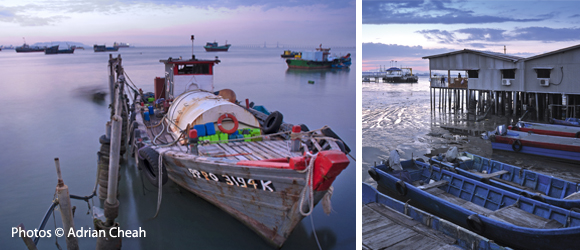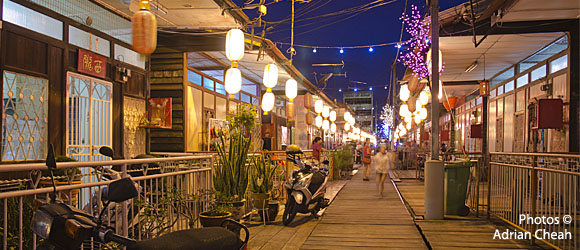Clan Jetties of Penang

"The wooden stilts are replaced every five years or so" explained Siew Pheng as we walked around the jetty. Siew Pheng, born and raised on Chew Jetty goes on to tell us that this labor-intensive task of replacing the wooden stilts is a dying trade as only a few old hands practice the skill. Many youngsters prefer not to live at the jetty, but in apartments and houses on Penang island itself, as the maintenance of these houses is backbreaking work.

A cluster of water villages along the southern stretch of Penang's Weld Quay, Chew Jetty is the largest of the seven clan jetties here. The Clan Jetties, so named as residents of each jetty share the same surname, have been in existence since the 19th century. Their wooden houses on stilts extend out to sea.

The history of the Clan Jetties is inextricably linked to the history of Penang. The jetties were established at a time when Penang's maritime trade was booming. The many Chinese immigrants who came to Penang in the early 19th century worked at the docks as coolies and sampan (boat) operators ferrying passengers and goods. It was only natural for them to build their homes by the water's edge as it was close to the port. The settlers of these jetties all hailed from the Tong An district in China's Fujian province. As more and more of their kinsmen arrived from China, more houses were built and the jetties extended further out to sea. The oldest jetty, the Chew jetty was established in the mid 19th century while the newest jetty, the Peng Aun and Mixed Clan jetty were established in the 1960s. In between, the Lee, Tan and Yeoh jetties were established in the late 19th century while the Koay Jetty was established in the 1950s.
As we made our way to Siew Pheng's home, we passed by two sundry shops, a hairdresser's and an Internet Café. From Siew Pheng's kitchen balcony, we could see neighbouring Lim Jetty and the Penang ferry making its regular run to the mainland town of Seberang Prai. A tiny red temple at the end of Lim Jetty faces the sea and I learned that every jetty has a temple at the end facing out to sea as an homage to the Gods, who in turn bestow good fortune on the residents.

Every year, during the eve of the ninth day of the Chinese New Year, Penangites join residents of the Chew jetty in an elaborate procession to honour the Jade Emperor.

At Chew jetty, home to 66 families, we saw a handful of tourists but mainly residents going about their daily activities. Walking along with the wooden plank ways, pass houses, some with tiny potted gardens; we glimpse a way of life that has withstood the pressures of modernisation and urbanisation. A cool breeze and the gentle lapping of the waves belie the proximity of the jetties to the commercial heart of Georgetown, a stone's throw away. Here, all are quiet and idyllic.
The homes on the Clan Jetties have all the trappings of modern life; running water, electricity, air conditioning and cable television. Only the sanitary services hark back to the 19th century, the sea it is!
As we made our way out of Chew jetty, we stopped at a shrine, this one at the entrance to the jetty. A simple structure adorned with red and gold lettering, the shrine had an altar, pictures of Chinese gods and large urns filled with joss sticks. The air was lightly scented with the smell of burning incense. A giant ancient banyan tree beside the shrine offers shade. Skirting the entrance of Chew jetty are hawkers selling noodles and dumplings, residents of the jetty earning their keep. The loss of Penang's free port status in 1969 translated to the loss of jobs for these maritime residents who then had to eke out a living on terra firma. However, their bond with the sea remains strong as some of the residents chose fishing as a livelihood while offering the occasional water taxi rides to visitors.

A short distance away is the Koay jetty. At first glance, Koay Jetty looks like any other jetty but it is not. While the inhabitants of the other six jetties are Taoists, the residents of Koay Jetty were Muslims. The 32 families, who share the surname Koay, are Chinese descendants of Arab traders.
Koay Jetty looks considerably older than Chew jetty. One reason offered by Siew Pheng is that at the Chew Jetty, no motorcycles are allowed to be ridden on the plank ways as these two-wheelers do considerable damage to the wooden planks. Just then as if to underscore Siew Pheng's point, a motorcycle comes trundling down the jetty and we hurriedly got out of its way. Exploring Koay Jetty, we walked gingerly on the planks, some visibly rotten, others pockmarked. Here the wooden houses flank only one side of the jetty, the other side being a mangrove swamp! Beyond that are public housing flats. The Koay Jetty does not extend out to the sea, as it is located on the mudflats. Mangrove swamplands teeming with herons, crabs and mud skippers was a sight to behold! Looking around, I saw homes modestly furnished. A pair of cyclos parked outside one unit silently announces its owner's occupation.
Sadly, the Koay jetty and its mangroves have become victims of redevelopment. Plans are underway to develop the area and neighbouring Peng Aun jetty into a housing project. The residents will be relocated to public housing flats while the wildlife will be relocated to a mangrove area on another part of Penang island.
The Clan Jetties are a living tradition, a unique community that has managed to stave off the tide of urbanisation for now. Back at the Chew Jetty, rows of wooden stilts and planks are laid out, waiting to rejuvenate a stretch ravaged by time and the elements.
---------------------------------------------------------
Written and photographed by Adrian Cheah © All rights reserved